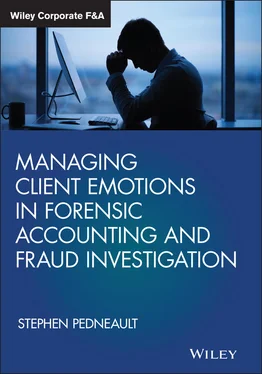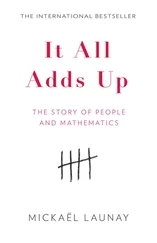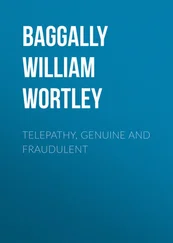When the client's attorney calls, they often describe their client's emotional state. If for some reason they don't, we ask them about emotional states as part of our triage process. When the client has a longstanding relationship with the attorney, we often receive a lot of background detail about the client and their emotional state. However, if the attorney is new to the client, we often are limited to comparing initial notes and impressions and must wait for the initial meeting to gather more detail.
While obtaining a brief summary of the matter, a fraud examiner should already be thinking about the types of emotions involved in the potential matter – not just the client's emotions, but the emotions of other parties involved as well. A fraud examiner can often predict the likely emotions to be encountered based on the limited facts provided, as well as how long the potential matter has been going on. The duration of the matter up to that point is often a good predictor of the emotional state of the parties.
If the potential matter has just been discovered or initiated, we often encounter denial or anger. If the matter has been pending for months or even years, the range of potential emotions can be much greater. As I discuss later in the book, individuals involved in financial matters requiring a fraud examiner often experience similar emotional states to people going through the grieving process (e.g., denial, anger, bargaining, depression, and acceptance). Depending on the timeline of the matter, the fraud examiner may be able to estimate the parties’ emotional states. (I choose the word “estimate” rather than “predict,” as I have sometimes been surprised to see the client's actual emotional state when we meet.)
Where practical, the fraud examiner should begin every new matter with an initial in‐person meeting. If the potential client cannot meet in person, the examiner should set up a virtual call. It's important for the fraud examiner to see the potential client, to visually assess them while listening to them talk. In these meetings, an experienced fraud examiner can gain a sense of the client's emotional state and size up whether they want to work with them. The same holds true in meeting an attorney. My firm has walked away from many great cases because we didn't want to work with a client or their attorney based on an impression we picked up on during the meeting.
In a few rare instances, my firm has lost a referral source for declining our involvement in a potential matter, but experience has shown me that I need to trust my instincts. When my sixth sense tells me something isn't right about an individual or a matter, I know I need to walk away. In some cases, I need to run. That turned out to be the case in the following story, where my instincts alerted me to something “not right” in the client's story.
I had scheduled a meeting with an attorney I'd worked with on past cases, regarding a matter where employees were stealing funds from an organization. As I regularly do, I brought someone from my office with me so the two of us could listen to the potential matter, assess emotional states, ask questions, and take notes. Often, the person I bring is the person who will work on the matter with me, so they can hear things firsthand right from the inception.
When we arrived, we met the attorney and several individuals who were sitting at a conference table. As the attorney introduced us to his clients, each expressed how excited they were to meet us and to gain our help in resolving their matter.
After the introductions, one of the individuals sitting at the head of the table identified himself as the executive director. He started talking about the organization, what it did, the locations that it had, the systems that it used … all to provide us background on the issues he was about to describe. He identified one particular location where he and the others in the meeting believed employees had been diverting funds. The primary people running the location were all related to each other: a husband and wife, their children, and other relatives. The executive director described the system that was used at the location, along with the system's known vulnerabilities.
Members of the parent organization had analyzed the activity of the location based on system reports for the past several years and found significant issues. Sales volume was too low and appeared to be manipulated – and although this location was one of their busiest, the sales volume and trends made no sense when compared to their other locations, which used the same systems. The executive director said that he and the others in the meeting were very frustrated with the individuals at that location and wanted to press further based on the initial analyses, but that they thought it would be more prudent to bring in an objective, neutral consultant, such as a fraud examiner, to further analyze the location's activity.
Listening to his story and looking at the very detailed analyses and spreadsheets they'd prepared, something just didn't feel right to me. I couldn't understand why, with the level of detail collected and analyzed, they didn't just go to law enforcement with their work and ask them to initiate a criminal investigation. I asked the group that very question. They responded that they wanted to be more thorough and prudent by getting an independent assessment. Their responses didn't make sense to me. Something seemed wrong.
The meeting continued, with the executive director telling us he had given his notice and would only be with the organization for another two weeks. I found that information troubling as well. I wondered what was really happening at the meeting and why this organization wanted to bring in outside fraud examiners when they had done much of the analysis themselves and at the time their executive director was leaving.
I asked them to describe the individuals who worked at the location in question. The executive director said the family was very close and controlled everything that happened at the location. He said that non‐family members had worked there in the past, but whenever they did not go along with what the family wanted, they were fired. Turnover among non‐family members was high, higher than at any other location. The executive director said he believed that the family was skimming cash from the daily sales and then concealing the thefts in the system, which would account for the sales and trends being so different from the other locations. The executive director said that the family members were not nice people and controlled all hours of operations by having at least one family member on hand at all times to watch over things. The family members had been very hostile toward other workers and had developed a sense of independence from the corporate office. Although the family had received requests for information as well as access to their systems, to date they had provided neither.
I sensed that the executive director and the others feared these individuals, something that made me very uncomfortable.
While my instinct was to decline our involvement, I first asked to know more about the family. The executive director said that the father, the patriarch of the operation, was also known as the unofficial “king” of his neighborhood, in one of the poorer areas of the city known for gang‐related activity and violence. I wondered to myself whether, had I not asked this question, the group would have kept that tidbit of information from us – a tidbit that formed a critical element relating to our safety if we were to get involved in the matter. I wondered what else the group had left out – and what their real motive was for our involvement.
Once the group finished talking, they asked me for my thoughts on how to proceed with their matter. I think they were shocked by my reaction and what I said next. I will never forget how their moods changed in response.
Читать дальше












